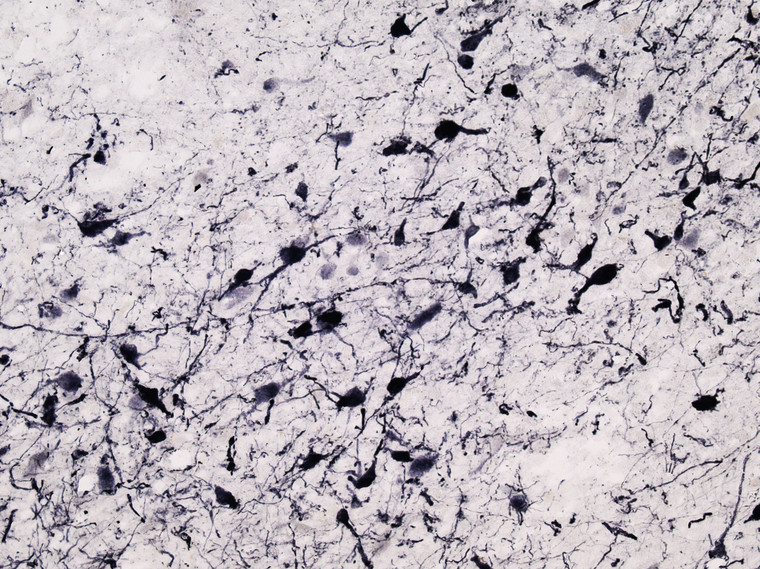| Host: |
Goat |
| Applications: |
Pep-ELISA/IHC |
| Reactivity: |
Human/Rat/Dog |
| Note: |
STRICTLY FOR FURTHER SCIENTIFIC RESEARCH USE ONLY (RUO). MUST NOT TO BE USED IN DIAGNOSTIC OR THERAPEUTIC APPLICATIONS. |
| Short Description: |
Goat polyclonal antibody anti-Tyrosine Hydroxylase (C-Term) is suitable for use in ELISA and Immunohistochemistry research applications. |
| Clonality: |
Polyclonal |
| Conjugation: |
Unconjugated |
| Isotype: |
IgG |
| Formulation: |
0.5 mg/ml in Tris saline, 0.02% sodium azide, pH7.3 with 0.5% bovine serum albumin. NA |
| Purification: |
Purified from goat serum by ammonium sulphate precipitation followed by antigen affinity chromatography using the immunizing peptide. |
| Concentration: |
0.5 mg/mL |
| Dilution Range: |
ELISA-antibody detection limit dilution 1:8000. |
| Storage Instruction: |
Store at-20°C on receipt and minimise freeze-thaw cycles. |
| Gene Symbol: |
TH |
| Gene ID: |
7054 |
| Uniprot ID: |
TY3H_HUMAN |
| Immunogen Region: |
C-Term |
| Accession Number: |
NP_954986.2; NP_000351.2; NP_954987.2 |
| Specificity: |
This antibody is expected to recognise all three reported isoforms (as represented by NP_954986.2; NP_000351.2; NP_954987.2). |
| Immunogen Sequence: |
VQDELDTLAHAL |
| Post Translational Modifications | Phosphorylated on Ser-19, Ser-62 and Ser-71 by several protein kinases with different site specificities. Phosphorylation at Ser-62 and Ser-71 leads to an increase of TH activity. Phosphorylation at Ser-71 activates the enzyme and also counteracts the feedback inhibition of TH by catecholamines. Phosphorylation of Ser-19 and Ser-62 triggers the proteasomal degradation of TH through the ubiquitin-proteasome pathway. Phosphorylation at Ser-62 facilitates transport of TH from the soma to the nerve terminals via the microtubule network. Phosphorylation at Ser-19 induces the high-affinity binding to the 14-3-3 protein YWHAG.this interaction may influence the phosphorylation and dephosphorylation of other sites. Ser-19 increases the phosphorylation at Ser-71 in a hierarchical manner, leading to increased activity. |
| Function | Catalyzes the conversion of L-tyrosine to L-dihydroxyphenylalanine (L-Dopa), the rate-limiting step in the biosynthesis of cathecolamines, dopamine, noradrenaline, and adrenaline. Uses tetrahydrobiopterin and molecular oxygen to convert tyrosine to L-Dopa. In addition to tyrosine, is able to catalyze the hydroxylation of phenylalanine and tryptophan with lower specificity. Positively regulates the regression of retinal hyaloid vessels during postnatal development. Isoform 5: Lacks catalytic activity. Isoform 6: Lacks catalytic activity. |
| Protein Name | Tyrosine 3-MonooxygenaseTyrosine 3-HydroxylaseTh |
| Database Links | Reactome: R-HSA-209905 |
| Cellular Localisation | CytoplasmPerinuclear RegionNucleusCell ProjectionAxonCytoplasmic VesicleSecretory VesicleSynaptic VesicleWhen Phosphorylated At Ser-19 Shows A Nuclear Distribution And When Phosphorylated At Ser-31 As Well At Ser-40 Shows A Cytosolic DistributionExpressed In Dopaminergic Axons And Axon Terminals |
| Alternative Antibody Names | Anti-Tyrosine 3-Monooxygenase antibodyAnti-Tyrosine 3-Hydroxylase antibodyAnti-Th antibodyAnti-TH antibodyAnti-TYH antibody |
Information sourced from Uniprot.org
12 months for antibodies. 6 months for ELISA Kits. Please see website T&Cs for further guidance






